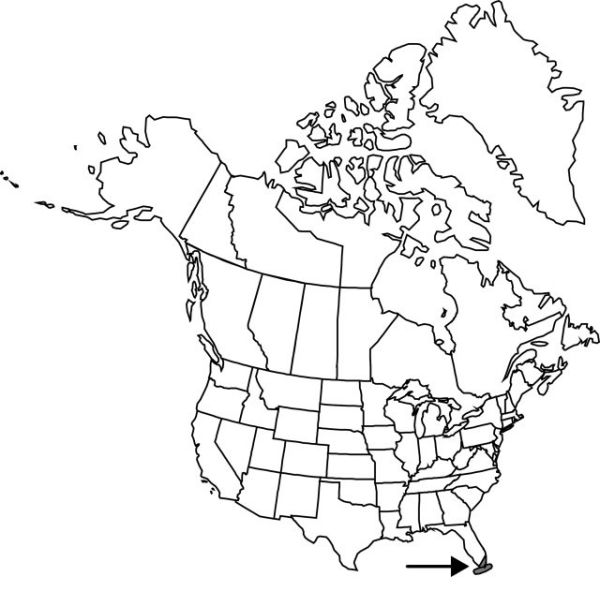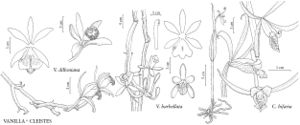Vanilla barbellata
Flora 48: 274. 1865.
Roots usually 1–2 per node, gray, 1–3 mm diam. when aerial, thicker and villous when in contact with substrate, glabrous. Stems occasionally branched, 3–9 mm diam., smooth. Leaves early deciduous; blade broad basally, otherwise narrowly lanceolate, relatively thin, to 4 × 0.8 cm. Inflorescences axillary on short lateral branches, several to many-flowered racemes, 1.5–6 cm excluding peduncle; floral bracts broadly ovate, 4–12 mm, fleshy. Flowers: sepals and petals green, somewhat spreading, distinct and free; sepals oblong-oblanceolate, 3–4 × 0.9–1.2 cm; petals oblong-oblanceolate, slightly falcate, dorsally keeled, 3–4 × 1–1.3 cm, apex acute to obtuse; lip greenish abaxially, deep red adaxially, shading to white margin, with broad, yellow midrib, overall triangular-obovate, medially thickened, apex 3-lobed, lateral lobes arching over column, orbiculate, margins involute, sinuses 4–5 mm deep, middle lobe reflexed, fleshy; disc with tuft of rigid, retrorse bristles; claw and basal margins adnate to proximal 1/2 of column; column straight, semiterete, 2.3–3.3 cm; pedicellate ovary 3–4.5 cm. Berries pendent, fusiform-cylindric, slightly curved, 7–9 cm × 9–13 mm.
Phenology: Flowering Apr–Jun.
Habitat: Mangroves, coastal hammocks, bay tree islands, rocky pinelands
Elevation: 0–20 m
Distribution

Fla., West Indies
Discussion
Vanilla barbellata is known in the flora area from several keys in Everglades National Park, Miami, Miami-Dade and Monroe counties, Florida (P. M. Brown 2002).
Selected References
None.
